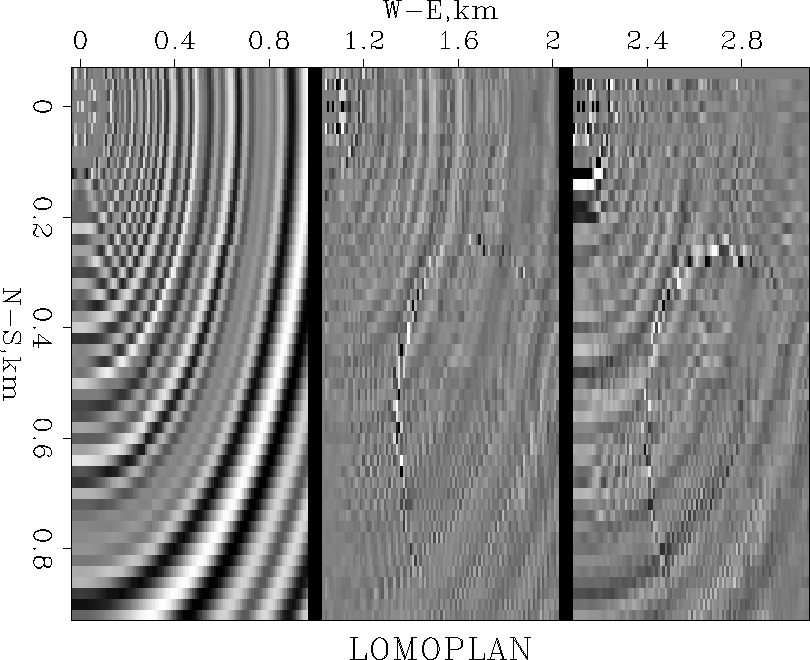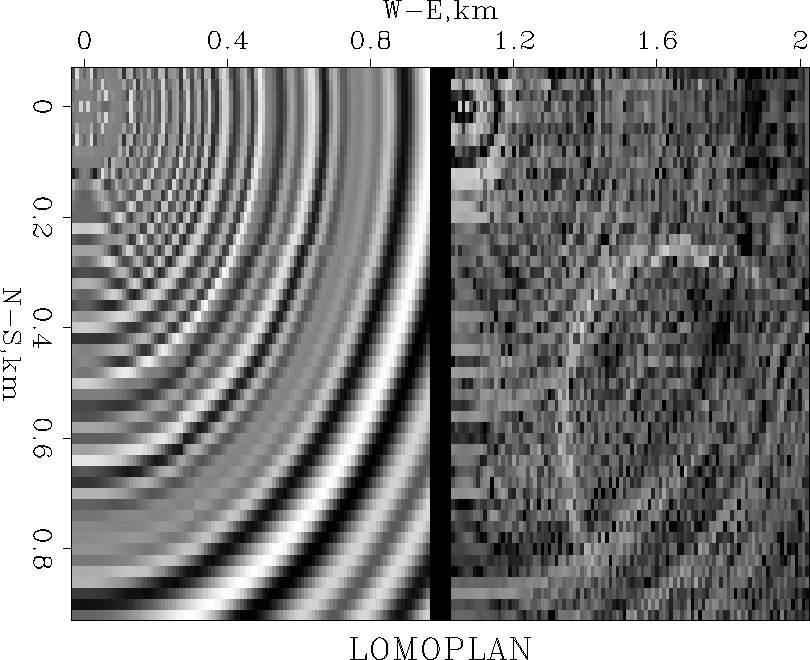




Next: FIELD DATA EXPERIMENTS
Up: SYNTHETIC EXAMPLES
Previous: SYNTHETIC EXAMPLES
Earlier 2-D migration and LOMOPLAN studies
such as 1992b
used a model called ``Sigmoid''.
I used the sigmoid model for several applications
and others also found it useful
Zhang and Claerbout (1992).
Using the same modeling concepts,
I set out to make a three-dimensional model.
The model has horizontal layers near the top,
a Gaussian appearance in the middle, and dipping layers on the bottom
with horizontal unconformities between the three regions.
Figure 1 shows
a vertical slice through the 3-D ``qdome'' model
and components of its LOMOPLAN.
There is also a fault that will be described later.
qdomesico
Figure 1
Left is a vertical slice through the 3-D ``qdome'' model.
Center is the in-line component of the LOMOPLAN.
Right is the cross-line component of the LOMOPLAN.





The most interesting part of the qdome model is the Gaussian center.
I started from the equation of a Gaussian
|  |
(2) |
and backsolved for t
|  |
(3) |
Then I used a random number generator
to make a blocky one-dimensional impedance function of t.
At each (x,y,z) location in the model
I used the impedance at time t(x,y,z),
and finally defined reflectivity as the logarithmic derivative
of the impedance.
Without careful interpolation (particularly where the beds pinch out)
a variety of curious artifacts appear.
I hope to find time to make a tutorial lesson on interpolation
from the experience of making the qdome model.
As a refinement to the model,
within a certain subvolume
the time t(x,y,z) is given a small additive constant.
This gives a fault along the edge of the subvolume.
Ray Abma defined the subvolume for me in the qdome model.
The fault looks quite realistic,
and it is easy to make faults of any shape,
though I wonder how they would relate to realistic fault dynamics.
Figure 2 shows
a top view of
the 3-D qdome model
and components of its LOMOPLAN.
Notice the cross-line spacing has been chosen to be double the in-line spacing.
Evidently a consequence of this in both
Figure 1 and
Figure 2 is that the Gaussian dome is not so well suppressed
on the crossline cut as on the in-line cut.
By comparison, notice that the horizontal bedding above the dome
is perfectly suppressed,
whereas the dipping bedding below the dome is imperfectly suppressed.
qdometoco
Figure 2
Left is a horizontal slice through the 3-D qdome model.
Center is the in-line component of the LOMOPLAN.
Right is the cross-line component of the LOMOPLAN.
Press button for volume view.





Finally, I became irritated at the need to look at two output volumes.
Since I rarely if ever interpreted the polarity of the LOMOPLAN components,
I formed their sum of squares and show the square root in
Figure 3.
qdometora
Figure 3
Left is the model.
Right is the magnitude of the LOMOPLAN
components in Figure 2.
Press button for volume view.










Next: FIELD DATA EXPERIMENTS
Up: SYNTHETIC EXAMPLES
Previous: SYNTHETIC EXAMPLES
Stanford Exploration Project
11/17/1997



